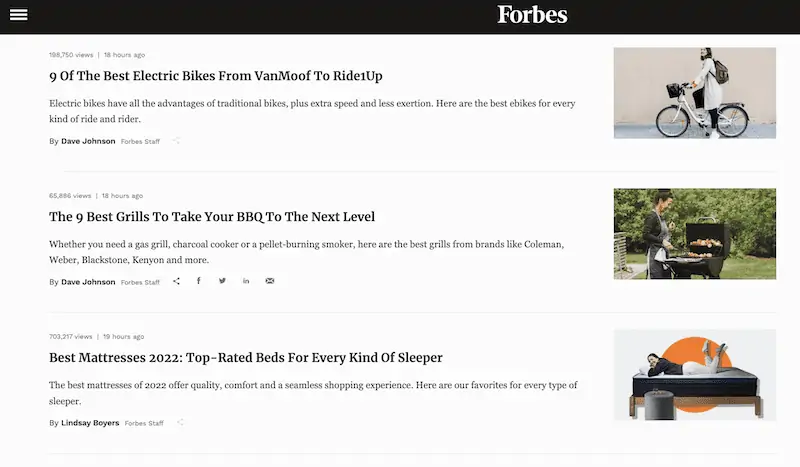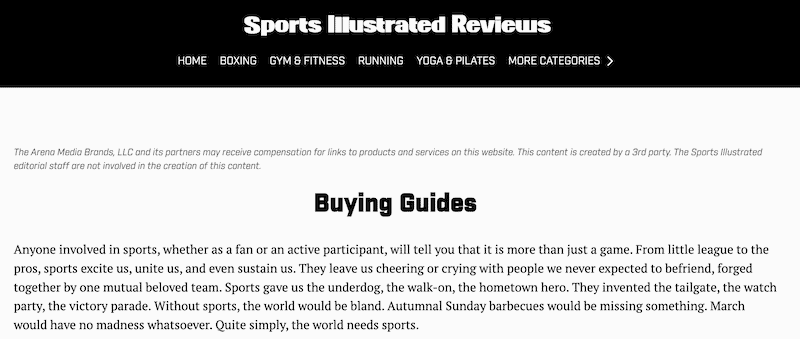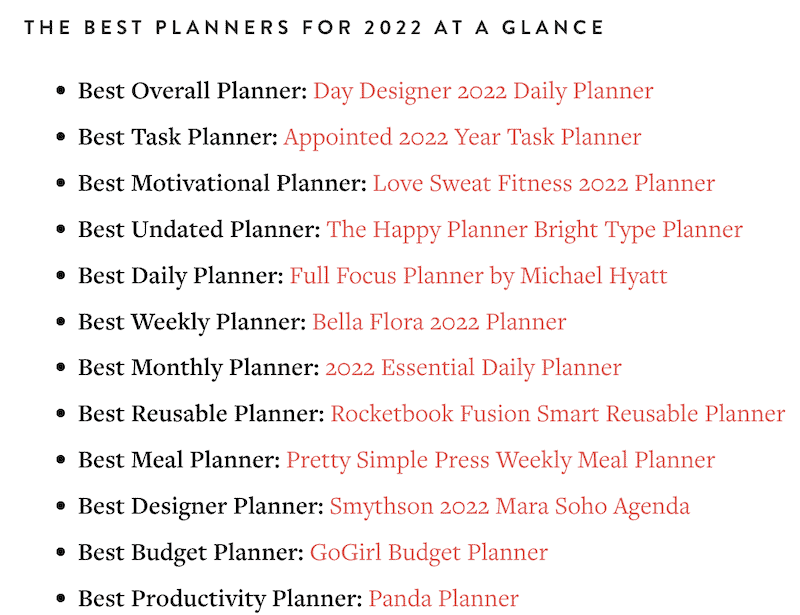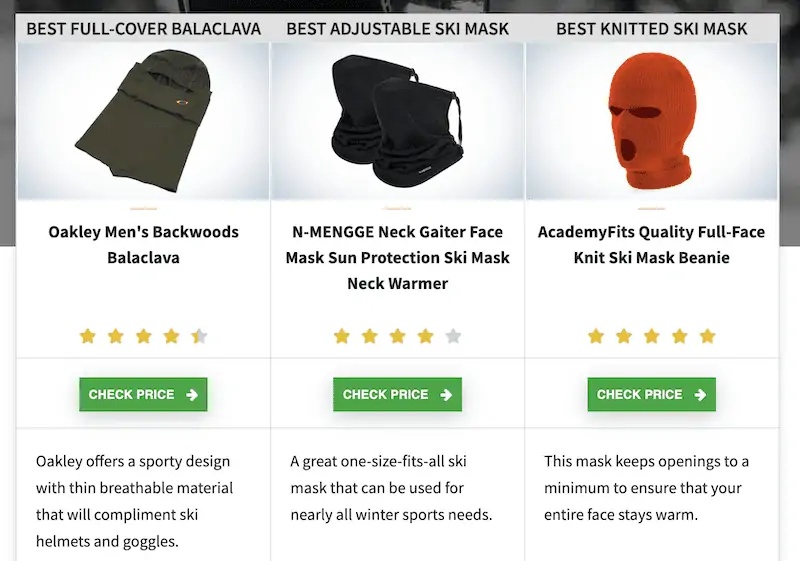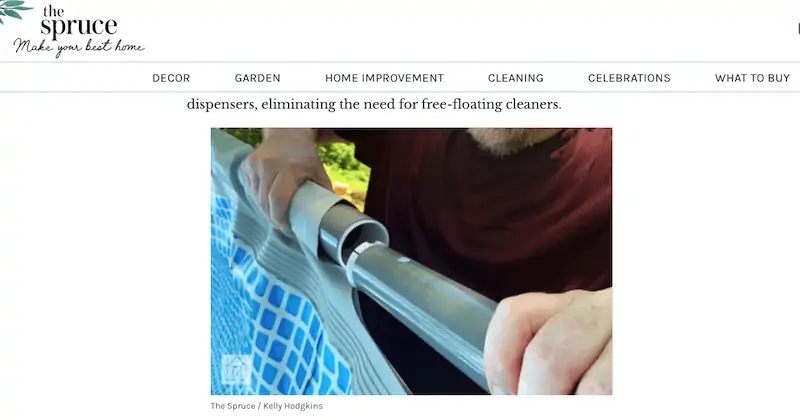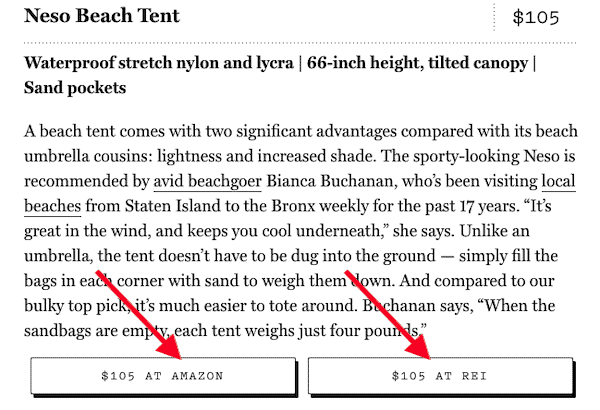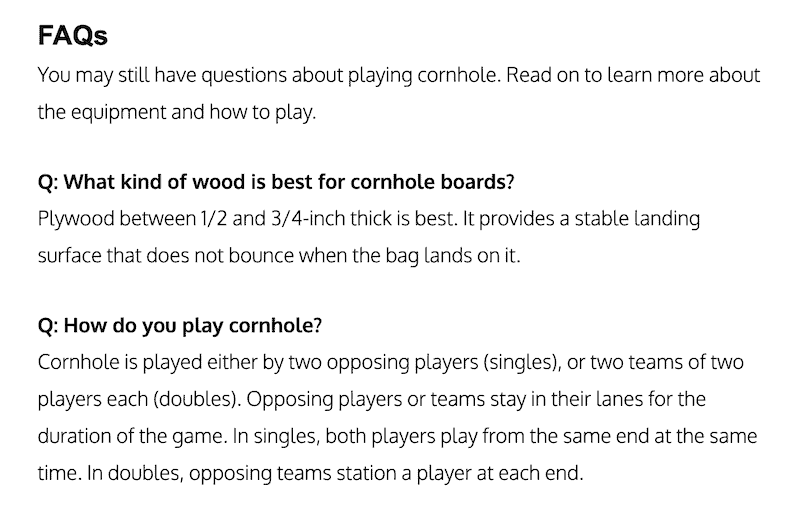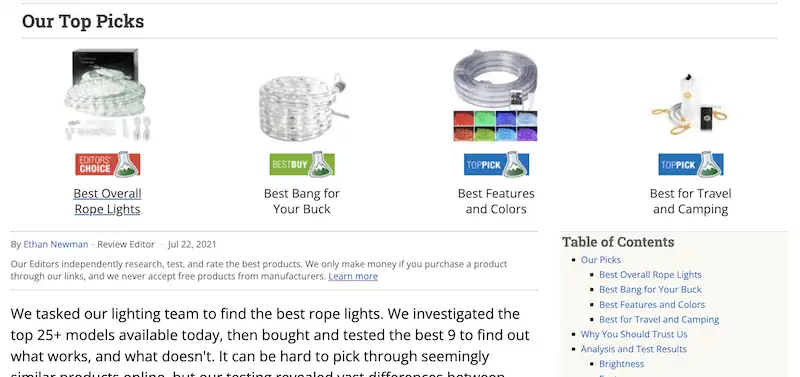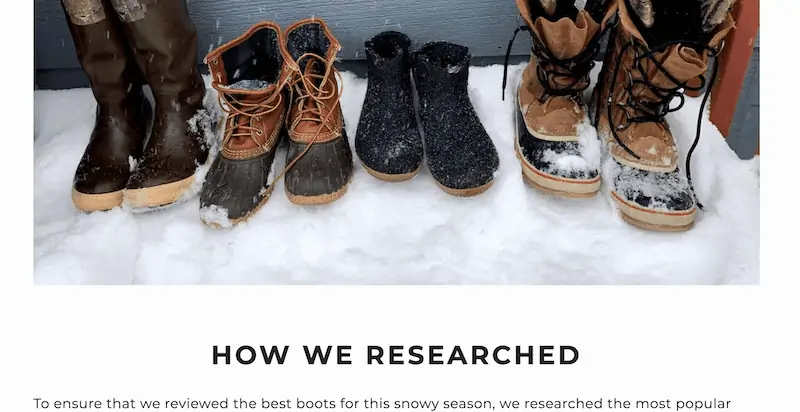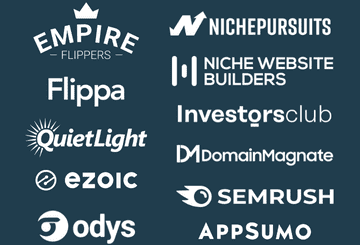In recent years, large media sites with millions of monthly visitors are increasingly adding commercial intent content, such as product reviews and buying guides.
I’ve reviewed the buying guides published by many large media sites and summarized the top insights in this analysis. I cover:
- Examples of large media sites creating affiliate buying guides
- Top affiliate tactics
- Tips for competing with large media sites for affiliate revenue
This analysis is a continuation of our analysis of niche affiliate sites but from the perspective of large authority sites doing the same thing.
Before we get into it, make sure to check out EasyWins which provides an actionable database of 120+ strategies used by both niche and large authority sites.
New Traffic Generated by Buying Guides
First, let’s analyze data on the sheer amount of traffic these large outlets are receiving from their buying guide content.
Here is a breakdown of the 7 largest sites:
| Site | Buying Guides | AHREFs Traffic |
| Forbes | 4,400+ | 3.7M+ |
| CNN | 3,200+ | 2.3M+ |
| Rolling Stone | 2,900+ | 2.8M+ |
| US News | 1,300+ | 2.5M+ |
| NY Times | 1,200+ | 13M+ |
| Men’s Health | 1,100+ | 685k+ |
| Sports Illustrated | 350+ | 390k+ |
Most of this traffic is relatively new since these brands only recently started publishing commercial-intent product-based content.
Why are Large Media Publishers Adding Buying Guides?
1. Very High Domain Authority
Large publishers from media companies naturally have a strong domain authority from thousands of external links often pointing to thousands of different pages. This makes it easier to rank for highly competitive keywords.
At the end of the day, backlinks are one of the most important ranking signals.
2. Strong Earning Potential of Affiliate Content
These companies know the strong earning potential of affiliate review content which often exceeds display ad earnings on a per visitor basis.
This was evident when it was revealed that The Wirecutter was generating $20 million per year for the New York Times as of 2018.
3. Google Prefers Strong Brands
Many of the most popular product keywords in Google are dominated by large publishers. Google often promotes well-known brands in their search results since searchers tend to trust their information.
Former Google CEO Eric Schmidt famously said “Brands are the solution, not the problem” in reference to how to filter out low quality sites in search results.
4 Examples of Large Media Sites Adding Product Reviews
1. Forbes
Forbes publishes a large number of buying guides at www.forbes.com/sites/forbes-personal-shopper/. The review section of their site has over 4,440 pages and nearly 3.7 million AHREFs traffic.
Famous for lists like the Fortune 500, many businesses are more than happy to link to articles where they have been featured by Forbes. This gives them a key advantage over most affiliate sites.
A unique tactic Forbes uses is that they put the date in many URLs, presumably to show Google and users that the content is fresh. Typically, you do not want to include the date in the URL since you will need to change the URL eventually or it will look outdated.
You can see the recent dates in URLs of their top 5 buying guide pages according to AHREFs.
Another interesting tactic is quoting an expert in the frequently asked questions section. This adds some useful information to the article and increases credibility by involving an expert. You could copy this technique by reaching out to an expert directly or submitting a request on HARO for a specific type of expert.
2. Encyclopedia Brittanica
Even publishers who do not typically cover consumer products are adding buying guides to their sites. The world’s first online encyclopedia, Encyclopedia Brittanica, covers an immense number of different topics with nearly 300,000 pages that generate 160 million AHREFs traffic per month as of May 2022.
According to Archive.org they just started the review section of their site in 2022. So far it has about 100 pages with just over 2,000 AHREFs traffic.
Encyclopedia Brittanica covers an extremely broad number of topics so they may not be getting much topical relevancy for reviews of specific products.
3. Merriam-Webster
Known for definitions of almost every word, Merriam Webster may be receiving less traffic from Google due to the increase in featured snippets for definitions in Google search results. Perhaps in response to a lower click through rate, they have recently started publishing reviews of popular products.
The review section at https://www.merriam-webster.com/reviews has about 390 pages with just over 16,000 AHREFs traffic. According to Archive.org, they started their review section in 2022.
While some pages get excellent traffic like “best fidget spinners”, they are often outranked for niche specific products by sites that focus on a specific niche. For example, a page about “best baby toys” is outranked by several baby or parenting sites with similar content and a lower Domain Rating.
4. Sports Illustrated
Sports Illustrated has about 350 buying guides published under their /review/ section that generate about 390,000 AHREFs traffic as of May 2022. They are focused on reviewing sporting goods and rank very well with an average of over 1,000 AHREFs traffic per article.
According to Archive.org, Sports Illustrated started its review section in 2021 and it is already generating a lot of profitable traffic.
11 Other Media Companies That Publish Buying Guides
There are numerous other publishers that publish buyer’s guides including:
- NY Times (Wirecutter)
- CNN
- NBC News
- Rolling Stone
- Lifewire
- Martha Stewart
- Good Housekeeping
- ZDNet
- The Spruce
- Bob Vila
- Men’s Health
7 Buying Guide Tactics Used by Large Publishers
1. Add a List of Text Affiliate Links
Several publishers like Forbes and Pure Wow include a long bullet list of text affiliate links in buying guides that include items like “best budget X” and “best X under $500”.
2. Add Trust Signals About Testing of Products
Many large publishers like ZDNet and NY Times seek to increase trust in their reviews by adding a message at the top of articles that explain that they independently test the products. They often have a “Why you should trust us” section that lists the author’s qualifications and explains their testing process.
Here is how ZDNet showcases trust:
Here is Wirecutter’s:
3. Add Tables to the Top of Articles
A table of products at the top of posts is a proven way to increase the click through rate to affiliate links.
4. Add Real Product Photos Taken by Author
One way the large publishers stand out from low quality affiliate sites is by taking good product photos rather than always using the manufacturers’ photos.
This helps increase trust that the author actually has experience with the products reviewed and can help pages rank higher since Google is looking to promote reviews that provide unique value.
In 2021, Google rolled out the Products Review Update to promote “high quality” product reviews that show evidence of actual experience with the products.
5. Link to Multiple Affiliate Programs
Google has stated that it is a best practice to link to multiple sellers to give visitors options of where to buy.
Large publishers typically work with multiple affiliate programs and provide CTAs to multiple sellers in the product boxes and throughout the article.
6. Include Display Ads on Buying Guides
Although some affiliate marketers think it is best to remove display ads on buying guides to increase click through rate, most large publishers keep display ads on their buying guides. Some of these publishers even have disruptive ads like Forbes’ popup ads that can block part of the content.
Display ads help increase revenue per visitor without significantly affecting the click through rate of affiliate links.
7. Add Additional Content About the Product
To lengthen the article, many publishers supplemented the review content with additional information about the product including:
- How to Shop for X (NBC News)
- Should you get an X (NBC News)
- Are X worth it? (Good Housekeeping)
- How do I choose a X? (Good Housekeeping)
- How we evaluated these X (Popular Mechanics)
They often include a frequently asked questions section with common questions about the products.
3 Examples of Niche Sites Outranking Large Publishers
1. Tech Gear Lab
Tech Gear Lab stands out from other affiliate sites because they test actual products and take original photos of the products. This helps keep them ahead of competitors as Google targets low value affiliate content with the Product Review update.
Despite a relatively low Domain Rating of 43 compared to large publishers, it outranks most sites for many product keywords like “best clock radio” and “best popcorn popper”.
2. Dive In
Dive In is an affiliate site that is crushing it in the water sports niche with an impressive number of top rankings for outdoor water related products and over 600k AHREFs traffic.
It ranks #1 in Google for over 4,000 keywords including keywords like “underwater camera”, “best paddle boards”, and “best dive watches”.
The site is run by diving experts who can demonstrate subject matter expertise and the site focuses on water sports with well organized topic clusters focused on categories like /diving, /beach, /paddle-boarding, and /swimming.
They also provide a badge award to top picks, which can be an effective way to build inbound links from highly relevant manufacturer websites.
Interestingly, they have branched out to snow related products and rank highly for a lot of skiing and snowboarding products as well.
3. Treeline Review
Treeline Review is a relatively small site with a modest Domain Rating of 34 that outranks more powerful domains on reviews of hiking and running products.
Their about page features a large list of contributors with extensive experience with hiking and running and their guides are much longer than most affiliate sites. Their page about “best men’s winter boots” contains nearly 10,000 words with many original photos of products.
6 Tips for Competing With Large Publishers
1. Avoid Mainstream Products
In most cases, writing a buyer’s guide on mainstream consumer products will be much too competitive and difficult due to the high authority of large publishers who target these products.
Instead, look for more niche products that may serve a very specific audience or purpose.
2. Target Alternative Keywords Instead of “Best X for Y”
In many cases, the keyword formula “best x for y” or “best x for 2022” will be too competitive and saturated, especially for mainstream consumer products. It is usually more effective to target variations that the large publishers are not covering in a specific article such as:
- best budget X
- best alternatives to [popular product]
- [product A] vs [product B]
- best X for [more specific type of buyer]
- best X brands
- X brands to avoid
- complaints about X
- best places to buy a X
3. Provide Unique Value to the Content
Often times, buyer guides by large publishers are not very in-depth since they typically focus on publishing a high volume of articles. By providing more unique value with original photos and testing results of actual products, you can stand out from the cookie cutter guides that some large publishers write.
Large publishers typically don’t provide video content in their articles, so this could be one way to add unique value and provide a more useful review (although very time consuming).
4. Highlight Your Expertise
Large publishers are generally good about highlighting the author’s expertise but when scaling they may hire freelance journalists without extensive experience on the topic. If you have a lot of expertise and experience in a particular niche, it is helpful to share this in a “why trust us” section.
5. Niche Down
Focusing your site on a narrow set of products in a particular niche can provide Google with strong topical relevance signals that can help you outrank a more general site.
For products that are related to a specific niche like outdoor, beauty, or kitchen, the buying guides from a niche relevant site are often more competitive with very high authority media sites.
6. Look for Low Competition Informational Keywords
It can be an effective tactic to add informational content to your site that targets low competition informational keywords and then linking to the related buying guide.
Not only is this a good way to increase overall traffic, link authority, and topical authority of your site, but it can also boost your buying guide SEO by passing internal link equity to it with descriptive anchor text.
You can also monetize these pages with relevant CTAs, contextual text affiliate links, and display ads.

